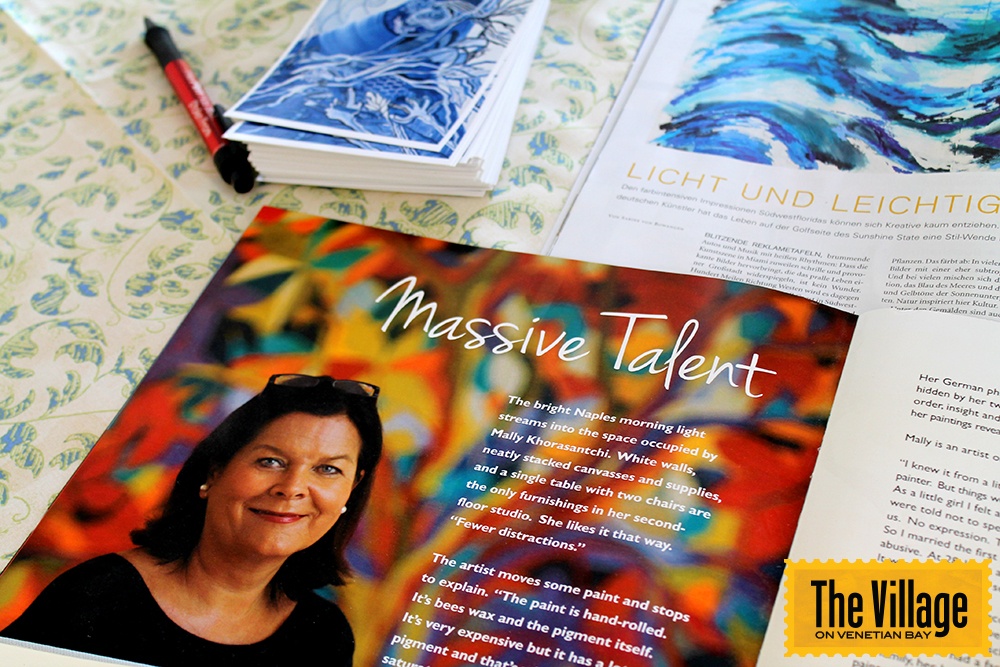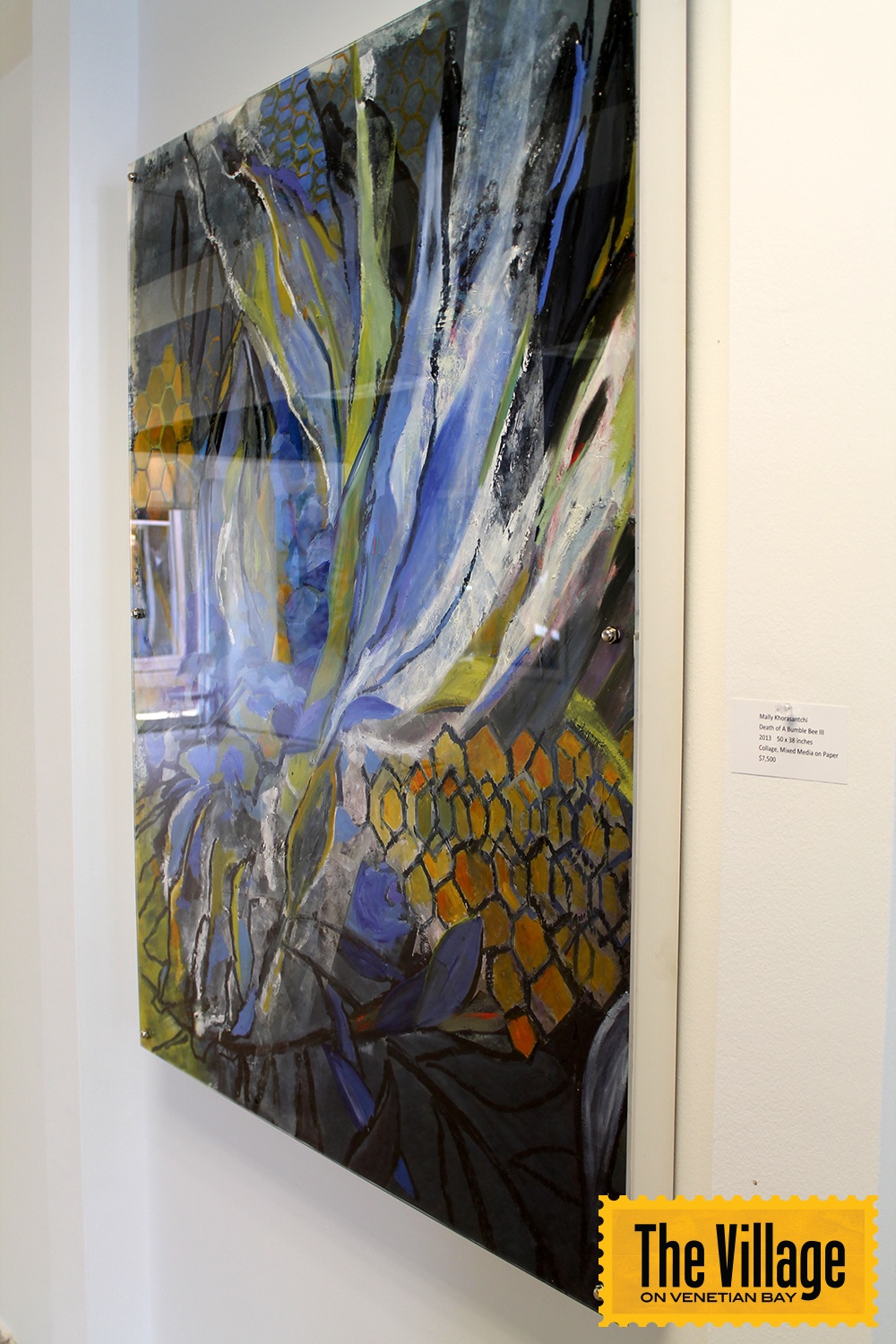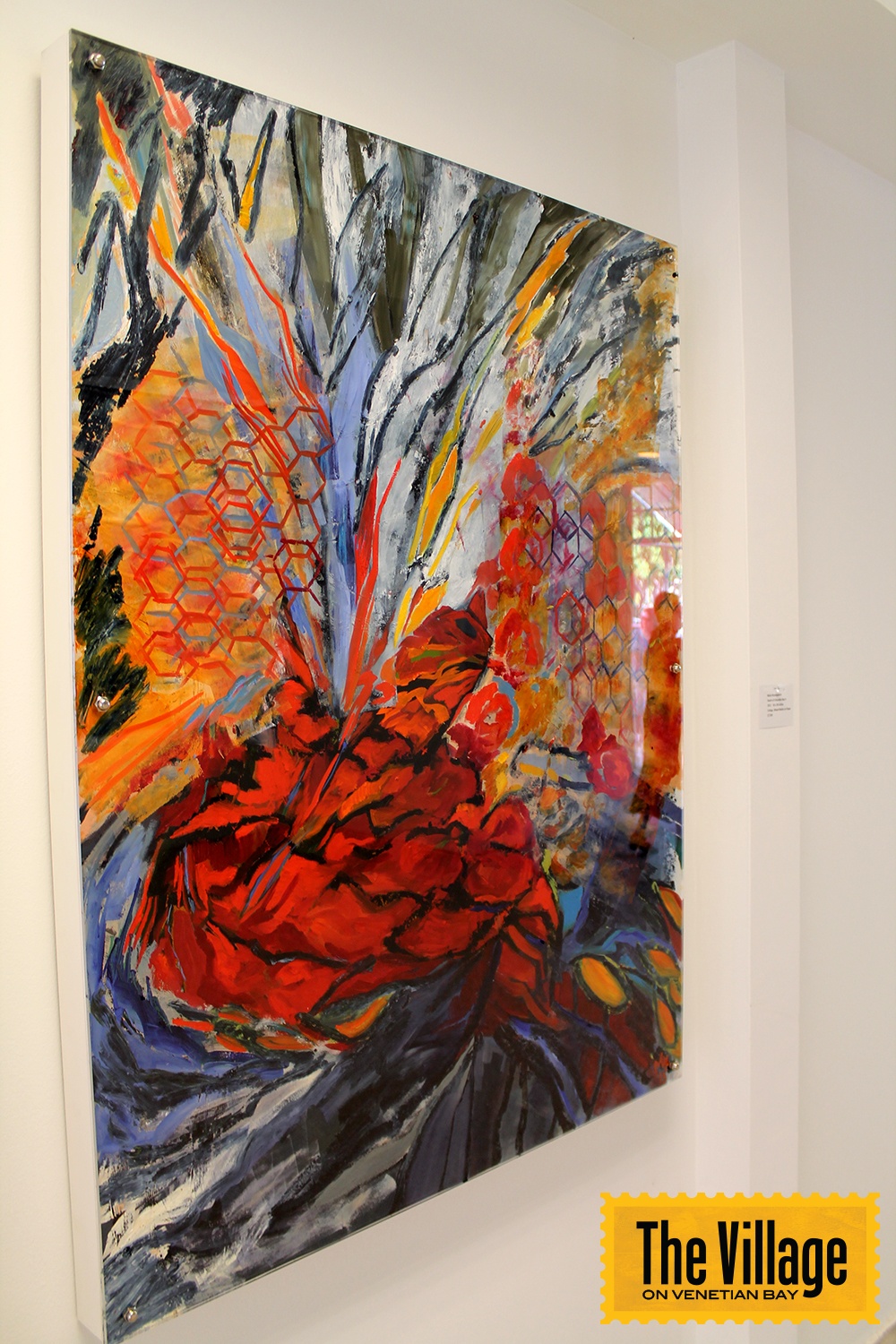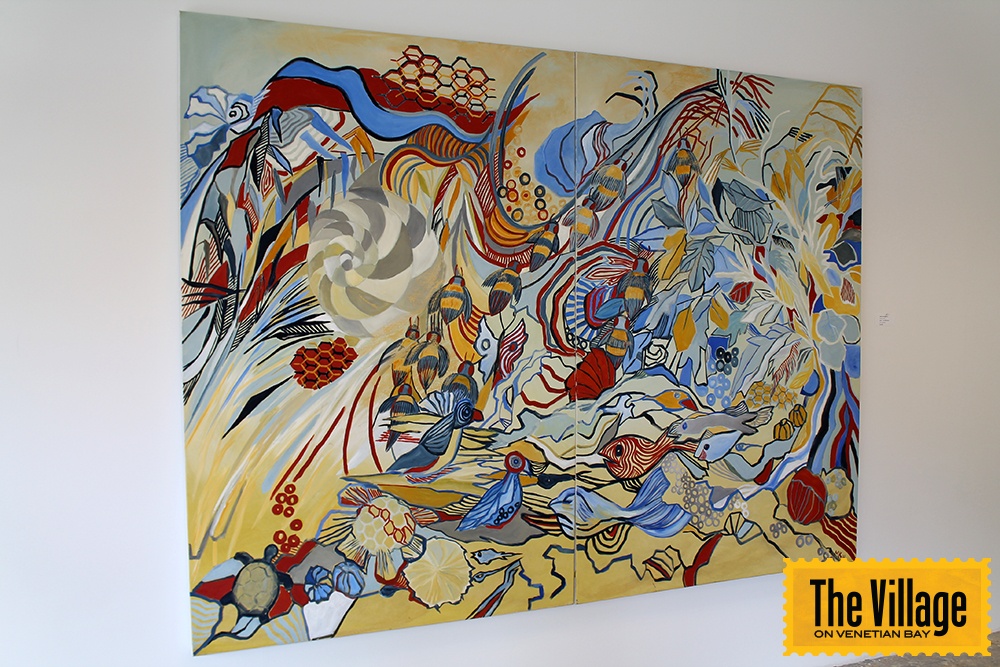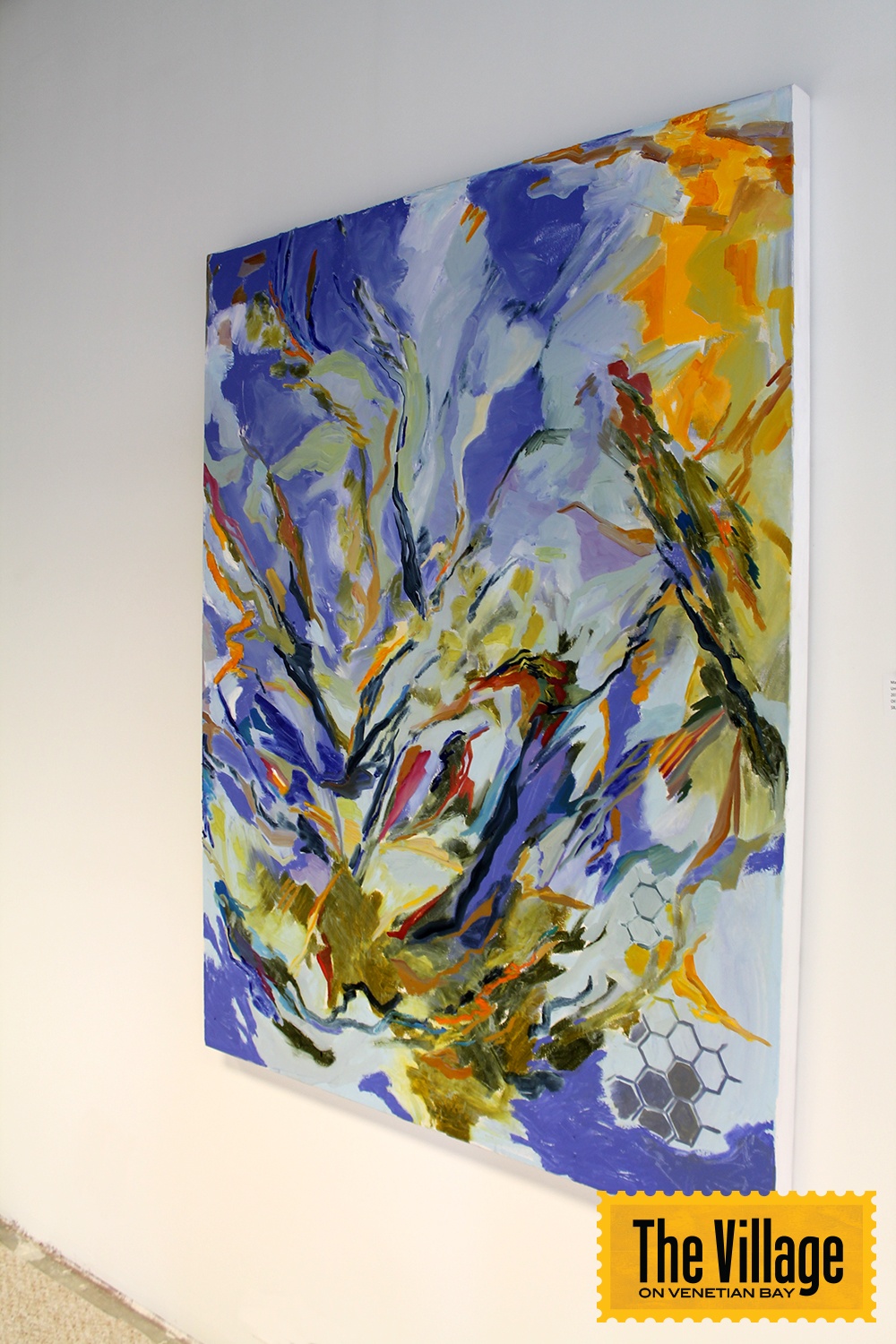Sometimes, good things come in large packages.
Mally Khorasantchi is a tall, exuberant woman who makes tall, extroverted paintings. The Naples resident, who will become president of the United Arts Council of Collier County's board of directors in July, is gradually making a path for herself as an expressionistic painter.
"There's a tremendous physicality to her work – the bold strokes, the rich colors, the references to literal and ephemeral thoughts. She's been successful in putting all that into her work," says Barbara A. Hill of Ft. Myers, an art consultant who has worked with Khorasantchi to help the artist cultivate her career. Hill is former executive director of the Naples Art Association.
"There's no way you can look at her work and not feel energized," Hill added.
Khorasantchi has an exhibit of paintings on canvas and paper on view until January 2011 in an unusual setting – an upscale furniture showroom. Twenty-one very large works can be seen on the walls of Webster & Company's Holly Hunt Showroom on the third floor of the Miromar Design Center in Estero.
In such an environment, many artists might fear being stereotyped as a producer of "sofa paintings," innocuous works intended for purchase by those seeking to match art to the color of their throw pillows.
But Khorasantchi, whose paintings are anything but inconspicuous, realized the high-ceilinged showroom would be perfect for works that are so large, in some cases, she can't even display them in her own studio.
For instance, her "Stingrays I," 2007, is 6 feet tall and more than 12 feet wide. It is modular, painted on six sheets of archival paper mounted under Plexiglas. The sea creatures swim through billows of turquoise paint, mellowed with brownish streaks. Thickly outlined and swathed in iridescent pigment laid on with oil sticks, the rays are colorful shapes coursing through the water.
Sunglasses art
Oil paint is Khorasantchi's medium of choice. She revels in its smooth, buttery quality. She also likes to lay down paint and then "destroy" it by wiping it off in some areas, creating a rich, streaky, multihued surface.
Color is a key player in her work as well. "I'm always attracted to color," Khorasantchi noted during a recent interview in the showroom.
That's a bit of an understatement, really. Her recent canvas, "The Roots of Thinking VI," 2010, is a candybox of color. High-pitched yellows, pinks, reds, tangerine, and vivid shades of blue coexist joyously in this flowing, abstract painting.
Its composition is dominated by a channel sweeping from top to bottom, filled with repeated hexagons. These cellular shapes evoke natural substances, for instance, honeycomb and certain rock crystals. For Khorasantchi, the shape represents a fundamental building block of life.
She has become interested in the work of German artist Joseph Beuys, for whom honey signified nourishment, social interconnection and spirituality. In his legendary performance, "How to Explain Pictures to a Dead Hare," in 1965, he smeared his head with honey and gold. His installation "Honey Pump in the Workplace," 1977, circulated two tons of honey through plastic tubes, powered by motors lubricated with margarine.
The charismatic Beuys, who died in 1986, was a neighbor of Khorasantchi's during the late 1970s in Dusseldorf, Germany, where she was born and raised. He was a famous teacher by then, but "I judged him to be an idiot" at the time, she said.
Lately, however, she's been exploring his ideas as well as reading the works of Rudolf Steiner. An Austrian philosopher who died in 1925, Steiner wrote extensively on natural science, politics, creativity, spirituality and education. His writings heavily influenced Beuys' thinking.
From learning to creating
Khorasantchi's newest paintings reflect her intellectual foraging, expressed as a greater freedom of movement and spatial complexity in her abstract works and an intensified environmental focus overall.
"Her work is becoming increasingly more insightful and there is more depth to the work because of the research she has been doing," Hill notes.
A major theme in Khorasantchi's art, literally and symbolically, is that of roots. She moved to the United States in 1992 at the age of 44, and became an American citizen in 2006. As an expatriate, her relationship to her past is complicated by the process of establishing herself in a new land.
When she moved to the United States and traveled the country, she says, what struck her initially was the sense of space and openness. In contrast to a crowded Europe, America felt vast and unspoiled.
She and her husband, Ali Khorasantchi, settled in Naples and opened businesses, and she immersed herself in the new landscape and social environment. She owned a makeup and nail salon, which eventually grew to two shops employing 18 people.
"It was my entry into the United States," she says of the salon business. "The diversity of people was amazing. And in a salon, people talk to you, they tell you everything. They gave me access to the whole culture."
In 2001, she sold the salons and found herself with time on her hands – time that could be devoted to art. Khorasantchi had been involved with art since she was a child and learned china painting as a young teen. In the 1980s, while raising a family, she studied drawing and painting at the Dusseldorf Academy of Art. Her paintings at the time tended toward floral subjects.
"They weren't that bad," she noted with a wry smile.
So she studied at the Naples Art Association and with abstract painter Hollis Jeffcoat, who'd opened a small, private school of art here. Khorasantchi enrolled in the New York painter Graham Nickson's painting marathons, which are intensive multiday sessions. She also studied in Connecticut with Hugh O'Donnell, a professor of art at Boston University. She and several friends banded together to share a studio space, calling it "Studio Blue."
Attracted to still life and landscape scenes, Khorasantchi found herself investing her subject matter with a gripping intensity. Her paintings of bananas, two of which are on view at Miromar, are striking both in scale and impact. A humble, everyday fruit, made monumental, suddenly seems like the most important thing in the world.
Nature beckoning
Mangrove roots have come to figure prominently in her work, too. Many of her paintings over the past five years depict tangles of roots, snarled and interwoven.
"On my walks, I was so fascinated by the roots around me here. They are always chaotic, always fighting for space," she explained.
A symbol of south Florida, the mangroves are an essential part of an increasingly fragile and threatened ecosystem. Her passionate renderings of the plants emphasize their role as a place where life is constantly churning, being born and dying.
Whatever her subject matter, Khorasantchi aims to be direct, spontaneous and true to her own experience. At times, she says, "I would like to be more subdued. I would like to be more civilized. I would like to be smaller. Then I see a tube of paint and I could just eat it up."
That kind of exuberance would be hard to squeeze into a small container.
Janice T. Paine is a free-lance writer on art who contributes regularly to the Naples Daily News. She is also program manager for education services at the United Arts Council of Collier County.





